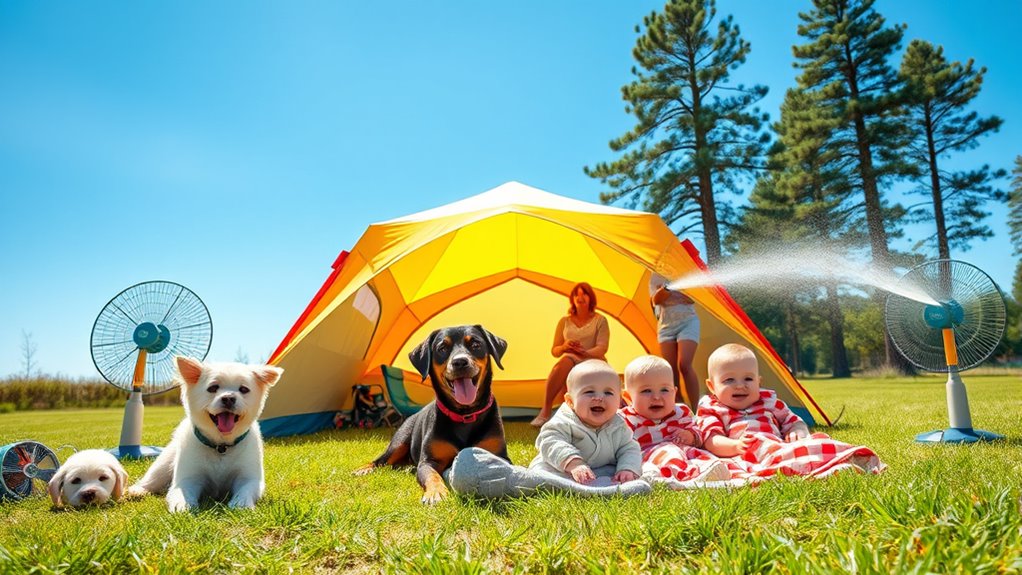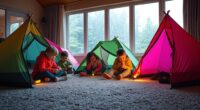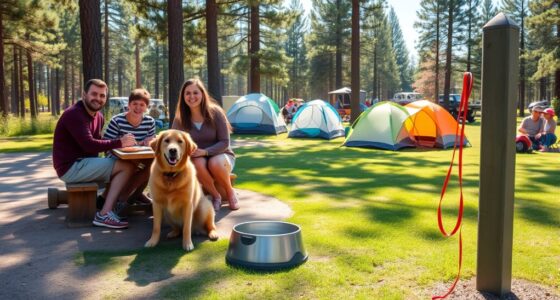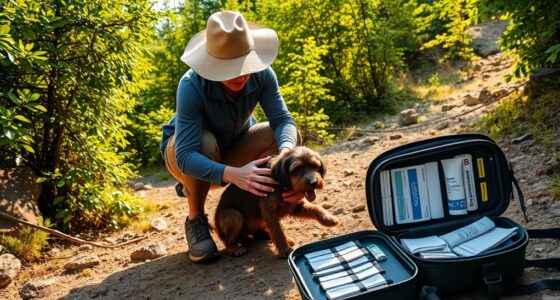To keep tents comfy for babies and pets, use reflective tarps and shading to block sunlight during the day, while installing ventilation to promote airflow and prevent stuffiness. Add ground insulation like foam mats under the tent or inside with thermal blankets to retain warmth at night. Proper placement in shaded areas and layered strategies will help stabilize temperature. Continue exploring these techniques to create a safe, cozy space no matter the weather.
Key Takeaways
- Use reflective tarp covers during peak sunlight to reduce heat gain and keep tents cooler for babies and pets.
- Incorporate ground insulation like foam mats or thermal blankets to prevent ground chill and stabilize interior temperature.
- Ensure proper ventilation with adjustable vents or open windows to regulate airflow and prevent overheating or stuffiness.
- Select shaded campsite locations under trees or natural cover to minimize direct sunlight exposure.
- Combine multiple strategies—insulation, shading, and ventilation—for a layered approach to maintaining a comfortable tent environment.
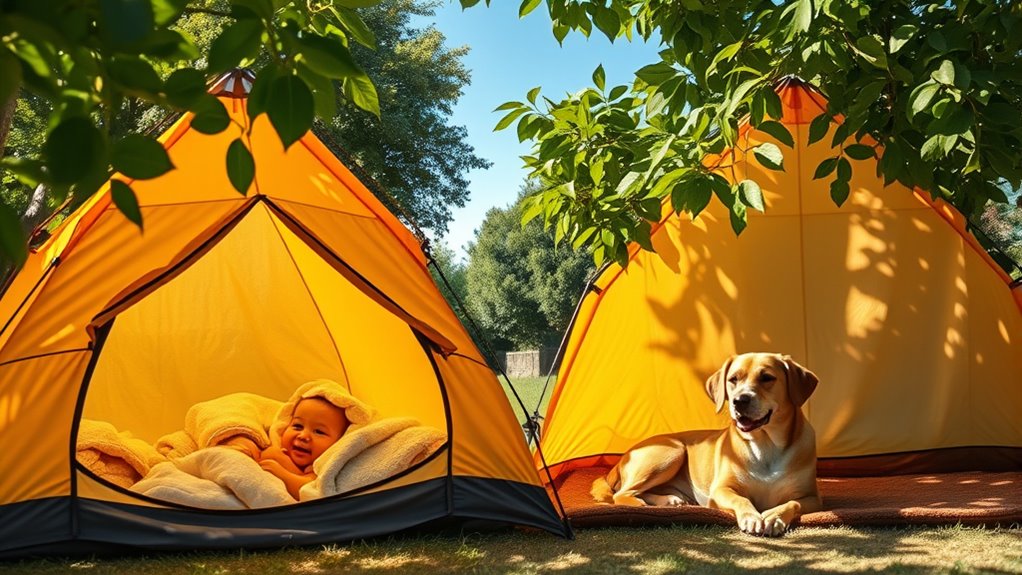
When camping with babies and pets, maintaining a comfortable temperature inside your tent can feel like a constant battle. The sun’s solar heat can quickly turn a cozy space into an oven during the day, making it difficult to keep your little ones and furry friends cool. To combat this, you need to think about effective insulation techniques that help regulate temperature. Reflective tent covers are a simple yet powerful way to reduce solar heat gain. These covers bounce sunlight away from the tent, preventing it from trapping heat inside. Placing a reflective tarp over the tent during peak sunlight hours can make a significant difference in keeping the interior cooler.
Use reflective tarp covers to bounce sunlight away and keep your tent cooler during peak heat.
Insulation techniques aren’t just about blocking heat; they also help retain warmth during colder nights. Using insulated tent pads or camping mats under your tent adds an extra layer of thermal resistance, preventing ground heat from seeping in and cooling the tent too quickly. Additionally, adding sleeping pads or foam beneath your tent walls can help insulate against the ground’s chill, maintaining a more stable temperature inside. If you’re camping in variable weather, consider lining the interior of your tent with thermal blankets or insulating materials that are lightweight and easy to pack. These can be draped over the walls or placed strategically to reflect body heat back inside, keeping everyone warm without risking overheating.
Another effective insulation technique involves choosing tents with built-in insulation or double-layer designs. These tents are crafted with materials that naturally reflect or trap heat, making them ideal for camping with babies and pets. Ventilation is equally important; proper airflow prevents stuffiness and helps regulate temperature. Use adjustable vents or open windows during the day to let in fresh air and close them at night to retain warmth. During hot days, keeping windows shaded with reflective covers or lightweight curtains can also reduce solar heat gain. Selecting a tent with good ventilation capabilities can significantly improve comfort levels by promoting airflow and temperature regulation.
Beyond structural solutions, consider the placement of your tent. Setting it up in shaded areas, under trees or natural cover, minimizes exposure to direct sunlight. This simple step can dramatically lower the internal temperature and create a more comfortable environment. Combining these insulation techniques with strategic positioning and ventilation, you’ll create a cooler, more comfortable space for your babies and pets, reducing stress and making your camping experience more enjoyable. Remember, managing temperature isn’t a one-time fix; it’s about layering solutions that work together to keep your tent’s interior just right, no matter how fiercely the sun beats down.
Frequently Asked Questions
How Can I Prevent Condensation Inside the Tent?
To prevent condensation inside your tent, focus on effective ventilation strategies like opening vents or windows to allow moist air to escape. Using moisture barriers, such as a groundsheet or tarp, can help reduce ground moisture seeping in. Additionally, keep the tent well-ventilated during and after use, and avoid bringing in excess wet gear. These steps help maintain airflow and minimize humidity, keeping your tent dry and comfortable.
What Are the Safest Materials for Baby and Pet Tent Liners?
You should choose safe, non-toxic liner materials for your baby and pet tents. Look for tent fabric and liner materials like organic cotton, bamboo, or polyester that are breathable and free from harmful chemicals. These materials help prevent irritation and guarantee safety. Always check for certifications like OEKO-TEX or GOTS to confirm the liners are safe for sensitive skin, making your tent a cozy, secure space.
How Do I Monitor Temperature Without Disturbing My Baby or Pet?
You can monitor temperature discreetly by placing a digital thermometer sensor in a safe spot near your baby or pet’s tent, avoiding direct contact. Use a wireless sensor or place a thermometer in a discreet area, like outside the tent, to track temperature changes without disturbance. Regularly check the readings on your digital device, ensuring a comfortable environment without waking or upsetting your little one or furry friend.
Can Portable Fans or Heaters Be Safely Used in Tents?
Portable fan safety and tent heater precautions are essential when using them in tents. Always choose appliances specifically designed for outdoor or camping use, and guarantee they have safety features like automatic shut-off. Keep fans and heaters away from fabrics and flammable materials, and never run them unattended. Proper ventilation is crucial to prevent carbon monoxide buildup, and follow manufacturer instructions closely. With careful use, you can safely maintain a comfortable environment inside your tent.
What Are Signs of Overheating or Chilling in Babies and Pets?
Did you know that over 80% of pet owners miss signs of overheating or chilling? When watching babies and pets, look for signs of distress like heavy panting, lethargy, shivering, or rapid breathing. Temperature fluctuations can cause discomfort, so keep an eye out for sweating or cold extremities. If you notice these signs, act quickly to modify the environment and ensure their safety and comfort.
Conclusion
Imagine camping with your baby and pet, both cozy and safe thanks to the right tent temperature. For example, a family used a portable fan and thermal curtains, ensuring their little one stayed comfortable despite outside heat. By adjusting vents and monitoring conditions, you can create a perfect environment for everyone. Don’t underestimate the power of small tweaks—they make all the difference in keeping your loved ones happy and safe on your outdoor adventures.

